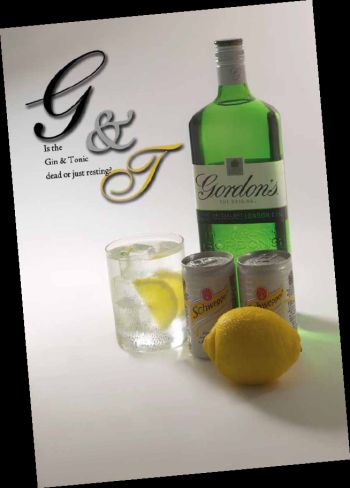articles/Business/ginandtonicmacrae-page1
Gin and Tonic for Mr MacRae please! - part 1 of 1 2 3 4 5
Published

The shot itself is simple to produce, and would look good in any photographer's portfolio. Control of exposure is essential; the main light comes from the left, with a second head backlighting the glass.
When shooting the glass or ceramic John always traces the lights down, to take off the hard edge and reduce the contrast a little. It gives a very appealing, soft highlight.
As a rule of thumb John uses a soft box about the same size as the product.
He recommends that you never use a very large soft box on small products as it tends to flood the set with light. This de-saturates the image, reduces the contrast and as a result degrades the quality of the final result.
The background is a Colorama roll and it deliberately allows areas for titles and copy to be set within the shot (oh joy - at last! Ed.) It also holds the green highlight in the shadows perfectly.
For this type of shot, cut a slice from a second lemon and put a couple of ice cubes in the bottom of the glass. Place the slices of lemon between the ice cubes and the edge of the glass to help make the lemon stand up. Then, arrange the rest of the ice cubes above, to prevent the lemons from floating to the surface when the gin & tonic is poured. Shoot quickly to keep the bubbles fresh; you can reduce the shutter speed down to a 1⁄15s to create slight movement of the bubbles in the glass.
Main Light f16
The backlighting illumination was approximately f161⁄2. John takes a reading from off the rim of the glass using the capture software for the Phase One back. By doing so he knows exactly what his highlight value is - he never exceeds 251 in RGB values and never allows burn-out in the highlights. Using a white card reflector to the right of the shot to fill in the shadows stops the tins from going too dark. Using a third head, to the right of the shot, cleans up the background at about f11 or f111⁄2. John then meters the background within the software, adjusts the lights accordingly and re-shoots when necessary.
The Gear
Camera Fuji GS680 with a PhaseOne digital back
tethered direct to a Mac Power Book and a 19" Lacie
CRT monitor.
Lens Fuji GS 135mm f5.6 with bellows lens hood
3x Bowens Gemini 500 Heads
Bowens Wafer Softbox
2x shapers and grids
Lastolite trace
You are currently on page 1
- Gin and Tonic for Mr MacRae please! page 1
- Gin and Tonic for Mr MacRae please! page 2
- Gin and Tonic for Mr MacRae please! page 3
- Gin and Tonic for Mr MacRae please! page 4
- Gin and Tonic for Mr MacRae please! page 5
1st Published
last update 09/12/2022 14:54:44
More Business Articles
There are 57 days to get ready for The Society of Photographers Convention and Trade Show at The Novotel London West, Hammersmith ...
which starts on Wednesday 14th January 2026




